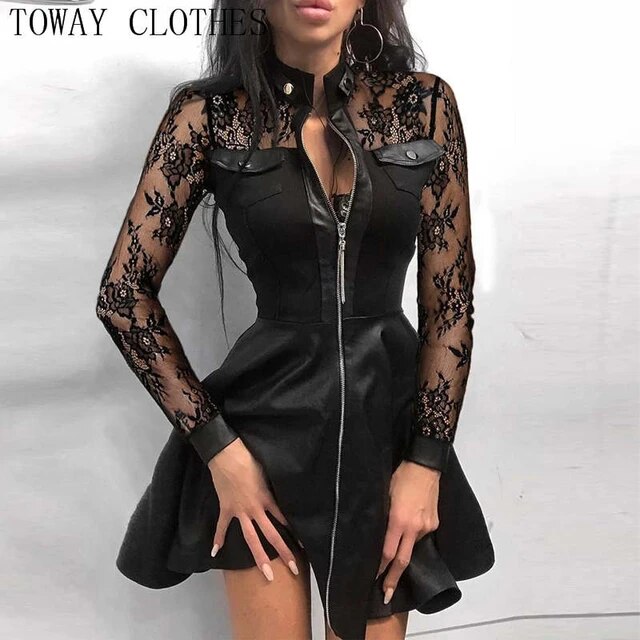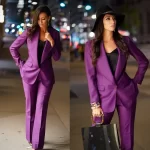Dressed in a little bit of leather and a little bit of lace means you rock with immense fashion taste all over the place.
“Give to me your leather…take from me my lace!”
Leather and lace, as polar opposites, represent tough and tender, but these blends work fabulously together to soften one (leather) and strengthen one (lace). Much like yin and yang…or masculine and feminine…leather and lace work well together! In the realm of clothing, wearing a mixture of the two fabrics looks downright splendid.
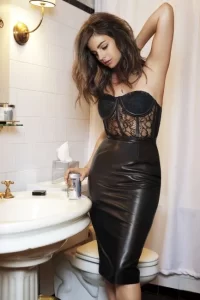

Leather is a durable and flexible material created by tanning animal rawhide and skin, often cattle hide. Leather can be produced at manufacturing scales ranging from cottage industry to heavy industry. People use leather to make various goods – including clothing (shoes, hats, jackets, skirts, trousers and belts). Leather is produced in a wide variety of types and styles, decorated by a wide range of techniques.
Lace is a delicate fabric made of yarn or thread in an open, weblike pattern. Lace can be made either by machine or by hand. Originally lace was made with linen, silk, gold or silver threads. Today lace is often made with cotton thread, although linen and silk threads are still available. Manufactured lace is generally made from synthetic fibers.
I feel that leather and lace wear so well together simply because they do represent such opposite characteristics, and when blended, the two work magically as one!
Leather Fun Fact: Several tanning processes transform hides and skins into leather: chrome-tanned leather, vegetable-tanned leather, aldehyde-tanned leather, formaldehyde, brain-tanned leather, chamois leather, rose-tanned leather, synthetic-tanned leather, alum-tanned leather and rawhide.
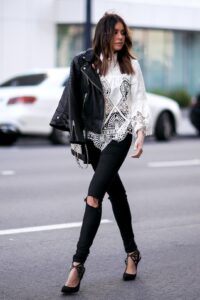
Lace Fun Fact: The word lace is from Middle English, from Old French las, noose, string and from Latin laqueus.

Types of Leather:
- Full-grain
- Top-grain
- Corrected-grain
- Split
- Buckskin
- Patent leather (my favorite…all shiny and pretty)
- Fish leather
Types of Lace:
- Needle lace
- Bobbin lace
- Cutwork
- Tape lace
- Knotted lace
- Crocheted lace
- Knitted lace
- Machine-made lace
- Chemical lace
Display your great fashion taste donned in a mix of leather and lace!
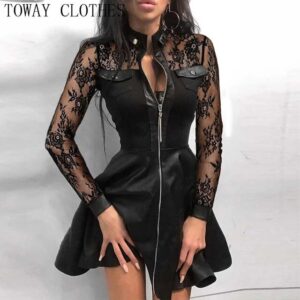
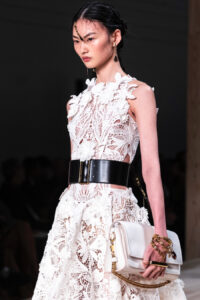
Probably because leather jackets are associated with many things, and often a staple for motorcycle groups, I love adding a pinch of lace when dressed in a stylish leather jacket. I particularly like the look of a blouse with laced sleeves worn underneath a leather jacket, where the lace collar of the blouse shows and a layer of lace peeks out of the jacket arms (around the wrists). It’s a tough and tender look! I think I’ll ride my motorcycle to the fashion show!

Leather Fun Fact: The leather manufacturing process is divided into three fundamental sub-processes: the preparatory stage, the tanning stage and the crusting stage.
Lace Fun Fact: The late 16th century marked the rapid development of lace; both needle lace and bobbin lace became dominant fashion as well as home decor. Lace was used by clergy of the early Catholic Church as part of vestments in religious ceremonies but didn’t come into widespread use until the 16th century in the northwestern part of Europe.
Leather and Lace: A clothing mix to embrace!

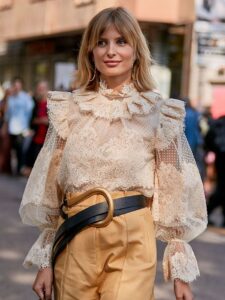
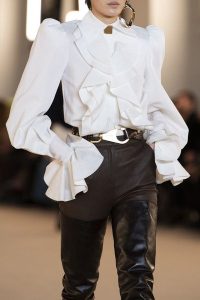
Leather Fun Fact: Enzymes like proteases, lipases and amylases have an important role in the soaking, dehairing, degreasing and bating operations of leather manufacturing. Proteases are the most commonly used enzymes in leather production. The enzyme must not damage or dissolve collagen or keratin, but should hydrolyze casein, elastin, albumin, globulin-like proteins and non-structured proteins that aren’t essential for leather making. This process is called bating.
Lace Fun Fact: The origin of lace is disputed by historians. An Italian claim is a will in 1493 by the Milanese Sforza family. A Flemish claim is lace on the alb of a worshipping priest in a painting around 1485 by Hans Memling.
Combined Leather and Lace Fun Fact: Dressed in leather and lace, looking both sweet and strong, a true fashion diva can never go wrong!
In addition to making for great garments, leather is also used for bookbinding, wallpaper, furniture, etc. Lace is often used for drapes, doilies and table cloths. However, leather when used to make clothing, and lace when used to make clothing, equals stunning, smashing and sexy.


Leather and Lace: An adorable clothing combination in all kinds of weather, with great fashion taste!
Leather and Lace: Make an eye-catching, entrancing entrance!
Leather and Lace: A Mix of Naughty and Nice!

Nancy Mangano is an American fashion journalist, screenwriter and author of the Natalie North murder mystery book series. Visit Nancy on her global online fashion/style/beauty magazine Nancy Marie Mangano Style at https://nancymariemangano.com, her Facebook page Nancy Mangano at https://www.facebook.com/nancymmangano/ Twitter @https://twitter.com/nancymangano and her author website http://nancymangano.com
